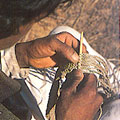Ply-splitting, one of the simplest forms of textile structure, is a commonly used technique the world over for the weaving of animal trappings; in Nepal, however, it is attached as a headband or tumpline to the traditional carrying-basket, dhoko, which is carried by porter(s) on their back(s). The namlo is strong and firm, yet flexible, and moulds itself comfortably over the porters forehead. It is also frequently used as a back strap as it serves the additional purpose of helping to balance evenly the load on the back. These headbands are made of varied fibres, including allo, jute, and sisal or bark, though allo produces the strongest bands.
The broad width of the namlo rests comfortably on the porters head; its importance can estimated from the fact that often porters are required to carry twice their own weight of load in the baskets that they lug uphill along sleep inclines. The Imperial Gazetteer of India (Provincial Series) on Nepal in 1908 states that:
The Bhotias carry enormous loads. It is by no means uncommon for a man to take two maunds, though one maund (8 lb.) is the regular load, and this has to be carried over hills several thousand feet in height where the paths are of the most primitive construction. The Bhotias always carry loads on their backs supported by a strap across the forehead….
Being porters – like trading and army service – offers a way of earning the supplementary income that is so essential in areas of scarce subsistence-level farming.
PROCESS & TECHNIQUE
Ply-split weaving is traditionally practised by men in Nepal. The namlo is woven all across Nepal wherever loads are carried in the dhoko. There are many variations in techniques, yet most commonly employed method of weaving the namlo is detailed below.
The procedure followed for ply-splitting is simple. The parallel plied warp strands are joined by crossing elements that do not interlace but split each warp strand in turn. The yarn is doubled and then folded in half – on an average the namlo is made of 12 warp strands, that are halved at their mid-point and folded into six strands. This is looped and the ends of the six ply cords are slipped on to a wooden stick or spindle that is sharpened at one end. For the relatively narrow initial and end part of the namlo a double-layered fabric of 2-3 cm is created.

The basic structure of ply- splitting is similar to plaiting in that the warp elements strands move diagonally down the fabric from selvedge to selvedge. The namlo is then turned over to the other side and the return passage is made with the darning yarn passing again under one ply of each of the 12 warp strands. This eventually results in a connected double layer with a v-shape pattern. The completed ply-split section of the namlo usually measures about 50 cm in length. The beginning and the end follow the same two-layer method in order to narrow down that section of the band that is attached to the basket; in spite of this the intrinsic strength remains.


